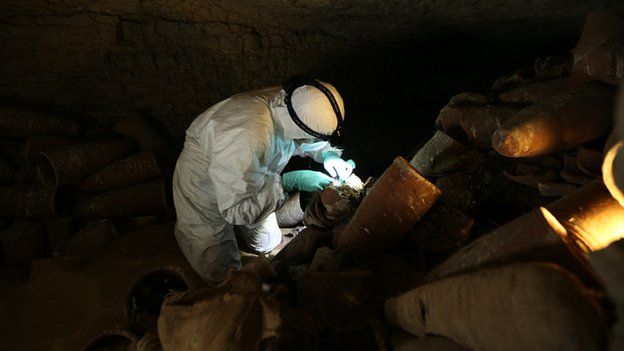A scanning project at Manchester Museum and the University of Manchester has revealed that about a third of the bundles of cloth are empty inside.
Researchers believe there was a huge appetite for these religious offerings, and demand for the mummies may have outstripped supply.
The project has been followed by the BBC's Horizon programme.
More than 800 mummies, ranging from cats and birds to crocodiles, have so far been analysed using X-rays and CT scans.The research team has been conducting the largest scanning project of its kind.
About a third of those scanned contain complete animals, which have been remarkably well preserved.
Another third contain partial remains - but the rest have been empty.
University of Manchester, said: "There have been some surprises.
"We always knew that not all animal mummies contained what we expected them to contain,
"Basically, organic material such as mud, sticks and reeds, that would have been lying around the embalmers' workshops, and also things like eggshells and feathers, which were associated with the animals, but aren't the animals themselves."Instead, she explained, the linen was padded out with other items.
Unlike human mummies, which were created to preserve the body for the afterlife, animal mummies were a religious offering.
"We know the Egyptians worshipped gods in animal forms, and an animal mummy allowed you some connection with the world of the gods, " explained Dr Campbell Price, curator of Egypt and Sudan, at Manchester Museum, which will have an exhibition on animal mummies in October.
"Animal mummies were votive gifts. Today you'd have a candle in a cathedral; in Egyptian times you would have an animal mummy.
"You would go to a special site, buy an animal mummy, using a system of barter. You'd then give it to a priest, who would collect a group of animal mummies and bury them."

Excavations have revealed that demand for these sacred gifts was high.
About 30 vast catacombs have been discovered in Egypt, packed from floor to ceiling with millions of mummies. Each tomb is dedicated to a single creature, such as dogs, cats, crocodiles, ibis and monkeys.
Scientists estimate that up 70 million animals may have been mummified by the Egyptians.
"The scale of animal mummification between about 800 BC and into the Roman period was huge," said Dr Price.
The researchers believe that despite the fact that animals were mass-bred, the mummy makers probably struggled to keep up with the demand."In terms of how many animals were reared and killed, it would have been on an industrial scale. The animals were young and killed when they were quite small. To achieve those numbers you had to have a very specific breeding programme."
However, they do not think that the partial or empty mummies were a scam, and the pilgrims may have known they were not burying a complete creature.
"We think there is probably more to it than that," Dr McKnight told the BBC.
"We think they were mummifying pieces of animals that were lying around, or materials associated with the animals during their lifetime - so nest material or eggshells.
"They were special because they had been in close proximity with the animals - even though they weren't the animals themselves.
"So we don't think it's forgery or fakery. It's just that they were using everything they could find. And often the most beautifully wrapped mummies don't contain the animal remains themselves."
Horizon - 70 Million Animal Mummies: Egypt's Dark Secret, will air on BBC 2 on Monday 11 May at 2100.
No comments:
Post a Comment